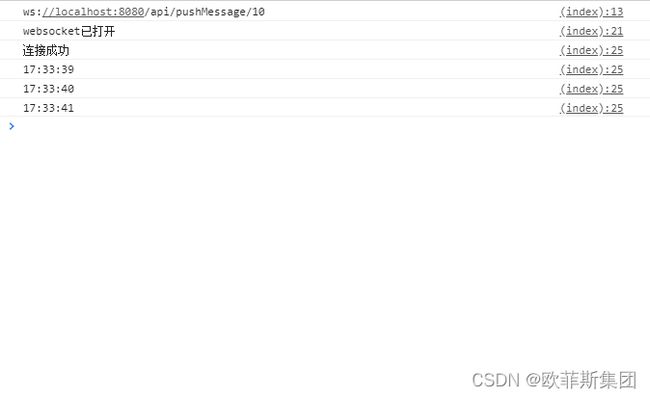springboot使用websocket实现服务端和客户端的交互
WebSocket是什么
WebSocket协议是基于TCP的一种新的网络协议。它实现了浏览器与服务器全双工(full-duplex)通信——允许服务器主动发送信息给客户端。websocket 协议是在 http 协议上的一种补充协议,是 html5 的新特性,是一种持久化的协议。
WebSocket的优势
我们都知道HTPP协议是基于请求响应模式,并且无状态的。HTTP通信只能由客户端发起,HTTP 协议做不到服务器主动向客户端推送信息。
举例来说,我们想要查询当前的排队情况,只能是页面轮询向服务器发出请求,服务器返回查询结果。轮询的效率低,非常浪费资源(因为必须不停连接,或者 HTTP 连接始终打开)。因此WebSocket 就是在这样的背景下发明的。
举个栗子
代码结构
-websocket
-config 配置
-WebSocketConfig.java
-controller 访问层
-TestController.java
-server 服务
-WebSocketServer.java
-service 服务类
-TestServiceImpl.java
-util 工具类
-CodesInfo.java
-ResponseBean.java引入maven
org.apache.commons
commons-lang3
3.8.1
com.alibaba
fastjson
1.2.28
org.springframework.boot
spring-boot-starter-websocket
websocket配置
/**
* WebSocket的配置信息
*/
@Configuration
public class WebSocketConfig {
@Bean
public ServerEndpointExporter serverEndpointExporter() {
return new ServerEndpointExporter();
}
}WebSocketServer 服务端
websocket服务端上重店的几个注解
@ServerEndpoint(/api/pushMessage/{userId}) 前端通过此 URI 和后端交互,建立连接
@Component 不用说将此类交给 spring 管理
@OnOpen websocket 建立连接的注解,前端触发上面 URI 时会进入此注解标注的方法
@OnMessage 收到前端传来的消息后执行的方法
@OnClose 顾名思义关闭连接,销毁 session
因为WebSocket是类似客户端服务端的形式(采用ws协议),那么这里的WebSocketServer其实就相当于一个ws协议的Controller
新建一个ConcurrentHashMap webSocketMap 用于接收当前userId的WebSocket,方便IM之间对userId进行推送消息核心代码如下
@Component
@Slf4j
@ServerEndpoint("/api/pushMessage/{userId}")
public class WebSocketServer {
/**静态变量,用来记录当前在线连接数。应该把它设计成线程安全的。*/
private static int onlineCount = 0;
/**concurrent包的线程安全Set,用来存放每个客户端对应的WebSocket对象。*/
private static final ConcurrentHashMap webSocketMap = new ConcurrentHashMap<>();
/**与某个客户端的连接会话,需要通过它来给客户端发送数据*/
private Session session;
/**接收userId*/
private String userId = "";
/**
* 连接建立成
* 功调用的方法
*/
@OnOpen
public void onOpen(Session session,@PathParam("userId") String userId) {
this.session = session;
this.userId=userId;
if(webSocketMap.containsKey(userId)){
webSocketMap.remove(userId);
//加入set中
webSocketMap.put(userId,this);
}else{
//加入set中
webSocketMap.put(userId,this);
//在线数加1
addOnlineCount();
}
log.info("用户连接:"+userId+",当前在线人数为:" + getOnlineCount());
sendMessage("连接成功");
}
/**
* 连接关闭
* 调用的方法
*/
@OnClose
public void onClose() {
if(webSocketMap.containsKey(userId)){
webSocketMap.remove(userId);
//从set中删除
subOnlineCount();
}
log.info("用户退出:"+userId+",当前在线人数为:" + getOnlineCount());
}
/**
* 收到客户端消
* 息后调用的方法
* @param message
* 客户端发送过来的消息
**/
@OnMessage
public void onMessage(String message, Session session) {
log.info("用户消息:"+userId+",报文:"+message);
//可以群发消息
//消息保存到数据库、redis
if(StringUtils.isNotBlank(message)){
try {
//解析发送的报文
JSONObject jsonObject = JSON.parseObject(message);
//追加发送人(防止串改)
jsonObject.put("fromUserId",this.userId);
String toUserId=jsonObject.getString("toUserId");
//传送给对应toUserId用户的websocket
if(StringUtils.isNotBlank(toUserId)&&webSocketMap.containsKey(toUserId)){
webSocketMap.get(toUserId).sendMessage(message);
}else{
//否则不在这个服务器上,发送到mysql或者redis
log.error("请求的userId:"+toUserId+"不在该服务器上");
}
}catch (Exception e){
e.printStackTrace();
}
}
}
/**
* @param session Session
* @param error Throwable
*/
@OnError
public void onError(Session session, Throwable error) {
log.error("用户错误:"+this.userId+",原因:"+error.getMessage());
error.printStackTrace();
}
/**
* 实现服务
* 器主动推送
*/
public void sendMessage(String message) {
try {
this.session.getBasicRemote().sendText(message);
} catch (IOException e) {
e.printStackTrace();
}
}
/**
*发送自定
*义消息
**/
public static void sendInfo(String message, String userId) {
log.info("发送消息到:"+userId+",报文:"+message);
if(StringUtils.isNotBlank(userId) && webSocketMap.containsKey(userId)){
webSocketMap.get(userId).sendMessage(message);
}else{
log.error("用户"+userId+",不在线!");
}
}
/**
* 获得此时的
* 在线人数
* @return int
*/
public static synchronized int getOnlineCount() {
return onlineCount;
}
/**
* 在线人
* 数加1
*/
public static synchronized void addOnlineCount() {
WebSocketServer.onlineCount++;
}
/**
* 在线人
* 数减1
*/
public static synchronized void subOnlineCount() {
WebSocketServer.onlineCount--;
}
消息推送
至于推送新信息,可以在自己的Controller写个方法调用WebSocketServer.sendInfo()即可。程序中使用定任务不停的向客户端发送消息。
@Controller
@RequestMapping("/api/test")
public class TestController {
@Autowired
private TestServiceImpl testServiceImpl;
/**
* 启动页面
* @return
*/
@GetMapping("/start")
public String start(){
return "index";
}
@PostMapping("/pushToWeb")
public ResponseBean pushToWeb(@RequestBody CodesInfo info){
testServiceImpl.printTime();
return new ResponseBean(200, "success", "123456");
}
}
@Service
@EnableScheduling
public class TestServiceImpl {
//打印时间
@Scheduled(fixedRate=1000) //1000毫秒执行一次
public void printTime(){
SimpleDateFormat dateFormat = new SimpleDateFormat("HH:mm:ss");
String date = dateFormat.format(new Date());
WebSocketServer.sendInfo(date,"10");
System.out.println(date);
}
}
建立websocket连接
前端页面直接使用ws协议建立连接,const socketUrl = “ws://localhost:8080/api/pushMessage/” + $("#userId").val();
websocket通讯
【socket开启者的ID信息】:
【客户端向服务器发送的内容】:
【操作】:
开启socket
【操作】:
发送消息
运行结果
客户端连接到服务端
服务端推送数据到客户端
两个客户端相互发送消息
客户端10
客户端20
服务器日志
本文总结
本文先简单阐述了下websocket的概念,分析了websocket的优势,以及其与传统的http请求的区别与联系。有一个比较好的栗子可以供学习使用。未来可以在此基础上进行扩增一些操作一些更复杂更为精妙的功能。





